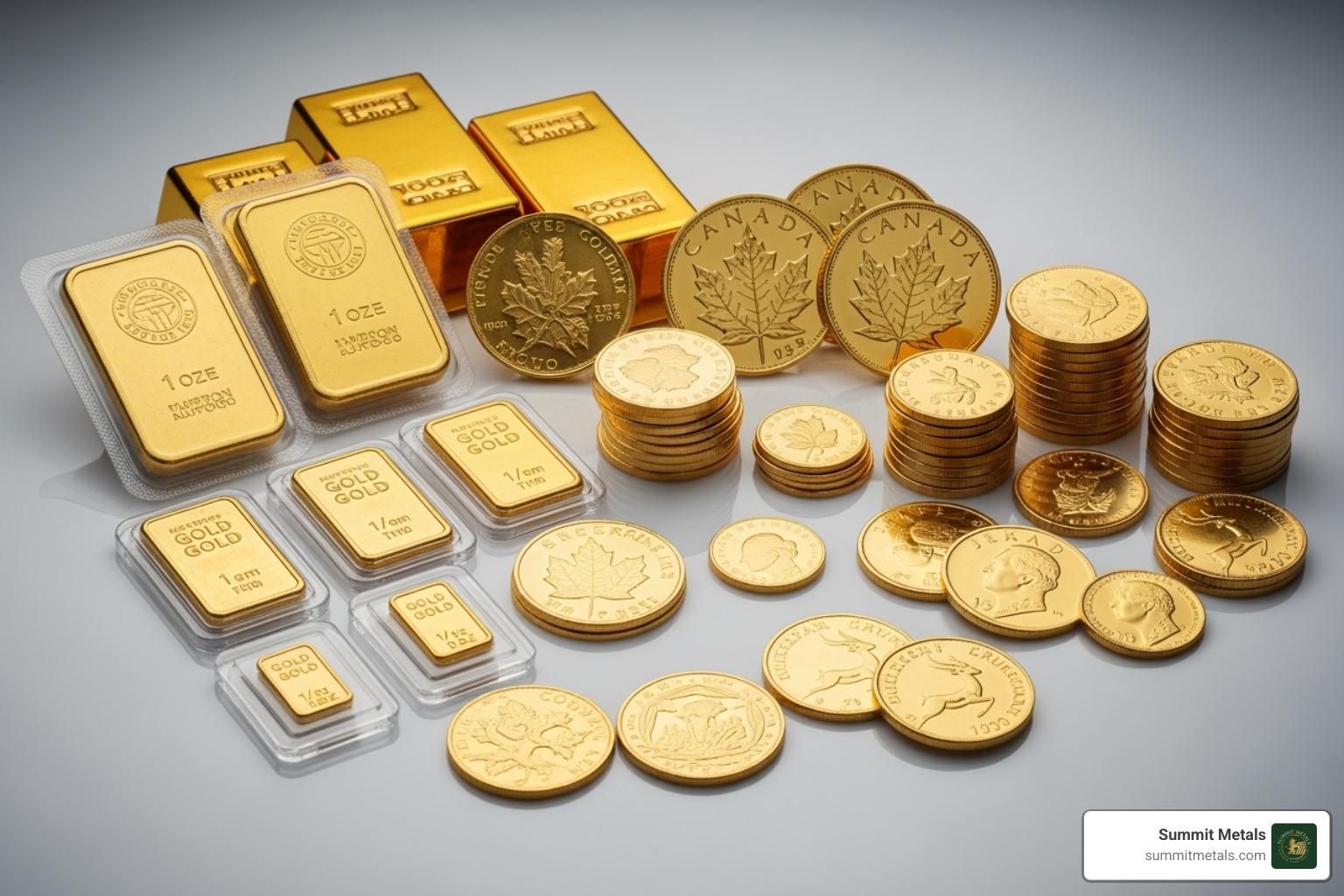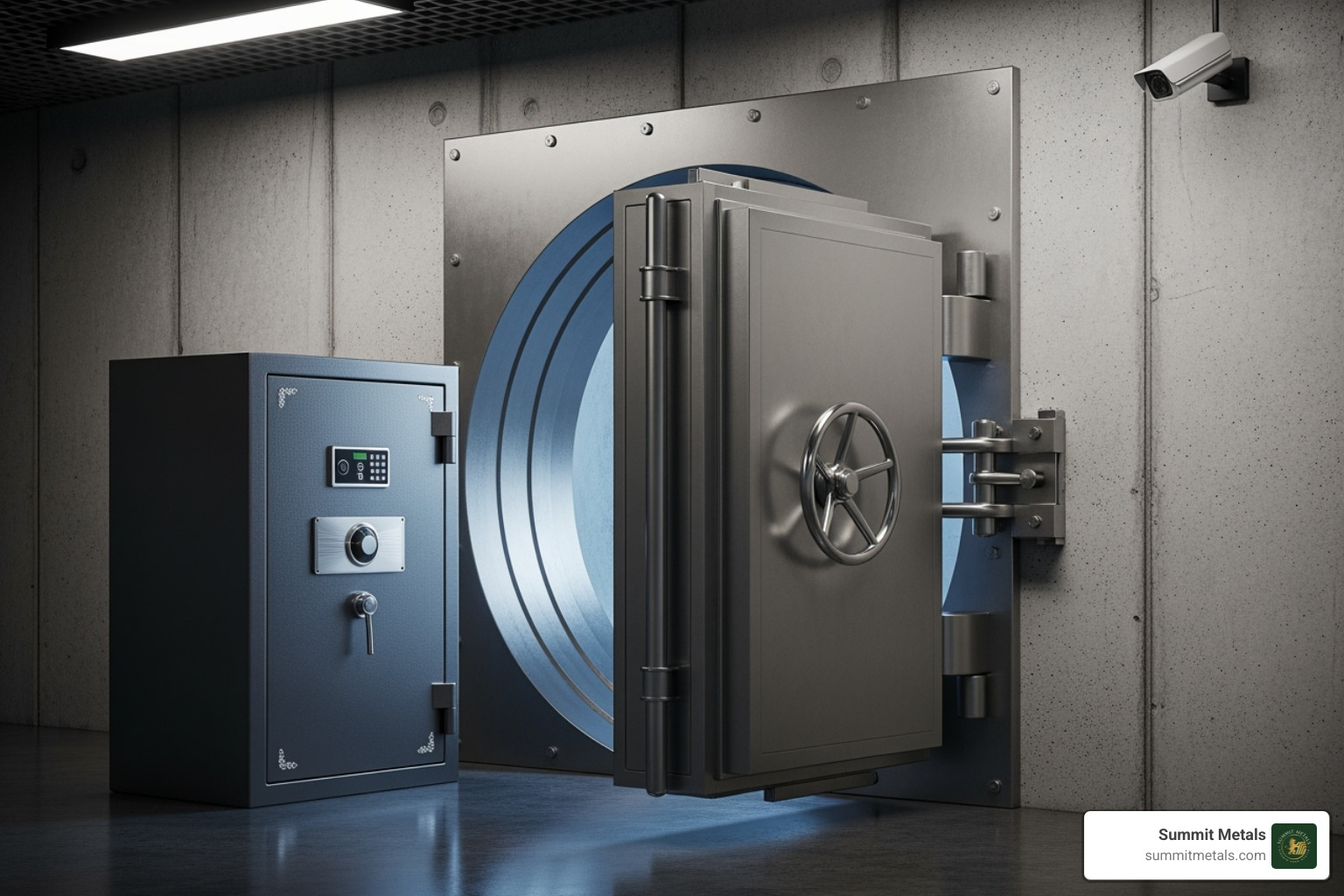Why Physical Gold Remains the Ultimate Financial Security in an Uncertain World
A physical gold purchase is one of humanity's oldest and most reliable methods of wealth preservation. It offers tangible security that digital investments cannot match. Whether you're looking to hedge against inflation, diversify your portfolio, or protect your wealth from economic uncertainty, buying physical gold provides direct ownership of a finite, universally recognized asset.
Quick Guide to Physical Gold Purchase:
- Choose your product - Gold coins (legal tender with fraud protection) or bars (lower premiums).
- Find a reputable dealer - Check BBB ratings and customer reviews.
- Understand total costs - Spot price + premium + shipping/insurance.
- Secure storage - Home safe or third-party depository.
- Plan your exit strategy - Know buyback policies and the selling process.
The appeal of physical gold is clear in the current economic landscape. Gold has outperformed the S&P 500 in 2024 and continues this trend into 2025, with some analysts predicting it could reach $4,000 by the end of 2026. Unlike paper assets that can vanish in market crashes, physical gold sits securely in your possession, immune to counterparty risk.
Physical Gold vs. Digital Alternatives:
| Feature | Physical Gold | ETFs/Mining Stocks |
|---|---|---|
| Ownership | Direct possession | Paper claim |
| Counterparty Risk | None | Yes |
| Storage Required | Yes | No |
| Liquidity | Moderate | High |
| Crisis Protection | Excellent | Limited |
Having spent over a decade on Wall Street advising Fortune 500 clients, I've seen how institutional investors use physical gold as a core defensive strategy. The same principles apply to your physical gold purchase decisions: it's about structuring defensive strategies that protect wealth over the long term.

Why Choose Physical Gold in Today's Market?

Think of gold as your financial insurance policy—one that's been paying out for over 5,000 years. While digital currencies and stocks fluctuate wildly, physical gold sits quietly in your safe, doing what it's always done: protecting wealth. The reason so many investors are making a physical gold purchase today is simple: when everything else gets shaky, gold stays solid.
- Inflation Hedge: Gold has historically maintained or increased its purchasing power when the dollar weakens. During the high inflation of the 1970s, gold prices soared from $35 to over $800 per ounce as the dollar's value fell.
- Portfolio Diversification: Stocks, bonds, and real estate often fall together during a market crash. Gold tends to move independently, often rising when other assets decline. This makes it an essential tool for diversification, as explained in The Role of Physical Gold Purchase in Diversifying Portfolio.
- Safe-Haven Asset: During economic crises like the 2008 crash, Brexit, or the pandemic, investors flock to gold for its stability. It's the financial equivalent of a sturdy umbrella in an economic storm.
- Wealth Preservation & No Counterparty Risk: Your gold's value doesn't depend on a CEO's decisions, a government's promises, or a bank's solvency. It is yours, period. This quality has made gold the go-to choice for families looking to pass real value to future generations. For more on this, see Why Gold and Silver: Understanding Their Value as Safe Haven Assets.
Physical Gold vs. "Paper Gold" (ETFs & Stocks): Why Physical Matters
Not all gold investments are created equal. There's a world of difference between holding actual gold and owning a piece of paper that says you own gold. "Paper gold" like ETFs and mining stocks might seem convenient, but they carry hidden risks that physical gold avoids. With tangible ownership, you're not betting on a company's management or trusting a fund's promises. You own the actual metal.
Let's break down the key differences:
| Metric | Physical Gold | "Paper Gold" (ETFs, Mining Stocks) |
|---|---|---|
| Ownership | Direct possession of actual metal | Paper claim or company shares |
| Counterparty Risk | Zero—it's yours completely | Yes—depends on others' promises |
| Storage | You handle it (home safe or vault) | Handled by others |
| Costs | Premiums, storage, insurance | Management fees, trading costs |
| Liquidity | Takes time to sell and get cash | Quick to buy/sell online |
| Crisis Protection | Works independently of financial system | Still tied to market systems |
The systemic risk factor is huge. During a financial crisis, paper investments can become worthless if the institution behind them fails, as investors in Lehman Brothers learned the hard way. Physical gold exists outside the financial system, so it doesn't have this problem.
Furthermore, management fees on ETFs, though seemingly small, compound over time. Mining stocks add another layer of risk; you're investing in a company's ability to operate successfully, which is subject to labor strikes, environmental issues, and poor management. What's the Difference Between Physical Gold, Silver, and ETFs? explains these distinctions in more detail.
At Summit Metals, we believe that when you want gold's protection, you should own the actual metal—not someone else's promise.
Note: Summit Metals specializes exclusively in physical gold and does not offer or recommend ETFs, mining stocks, or other "paper gold" products.
Your Step-by-Step Guide to a Physical Gold Purchase

Making your first physical gold purchase doesn't have to be overwhelming. The process involves a few key steps: researching trustworthy dealers, choosing the right products, understanding the costs, and arranging secure shipping. Each step builds on the last, creating a foundation for confident investing.
For those new to precious metals, we highly recommend reading How to Buy Gold and Silver Online Safely before diving in. Knowledge is your best protection against costly mistakes.
Step 1: Choosing the Right Gold Product for You
The gold bars vs. coins debate is common, and the right answer depends on your goals. For a detailed comparison, see How to Compare Gold Bars vs. Gold Coins: 5 Factors to Consider.
Gold Bars are efficiency champions, typically carrying lower premiums over the spot price, especially in larger sizes. They are also compact, making them ideal for storing substantial value.
Gold Coins offer legal tender status and government backing. Coins like the Canadian Maple Leaf or American Eagle are highly recognizable and include anti-fraud features, which can make them easier to sell.
Gold Coin vs. Gold Bar at a Glance
Gold Coin Benefits:
- Legal Tender Status: Backed by a government, providing an extra layer of trust.
- Anti-Fraud Features: Modern coins include micro-engraving and other security elements.
- High Recognition: Globally recognized, making them easy to authenticate and sell.
- Flexibility: Smaller denominations are easier to liquidate partially.
Gold Bar Benefits:
- Lower Premiums: More gold for your money, especially with larger bars.
- Efficient Storage: Compact and easy to stack for bulk storage.
- Simplicity: Valued purely for their weight and purity.
When buying, you'll also choose between bullion (valued for metal content) and numismatic coins (collector items valued for rarity). For investment, stick with bullion. Also, consider weight and size. While larger bars offer better value per ounce, fractional gold (e.g., 1/10 oz coins) provides flexibility for smaller transactions. Fractional Gold Bars: An Affordable Entry Point for Gold Investors explains this well. Finally, stick with recognizable mints like the U.S. Mint and Royal Canadian Mint for products that are easy to sell anywhere.
Step 2: Understanding the True Cost of Your Physical Gold Purchase
The spot price you see on financial news sites is the wholesale cost. As a retail buyer, you'll pay the spot price plus a premium, which covers minting, refining, and dealer costs. Premiums vary by product: coins usually have higher premiums than bars, and fractional pieces have higher percentage premiums than full-ounce products.
Be sure to account for all fees, including shipping, insurance, and any charges related to your payment method. Reputable dealers are transparent about all costs. Before buying, check the current spot price on a reliable financial news source to evaluate the premium you're being offered.
Bulk purchase discounts can significantly reduce your cost per ounce. Many dealers, including Summit Metals, offer tiered pricing for larger quantities. For a deeper understanding of how pricing works, read Spot Price vs. Premium: How Precious Metals Pricing Works.
Step 3: Finding a Reputable Seller
This step is critical. Online dealers like Summit Metals often offer the best selection and pricing due to lower overhead. Local coin shops provide a personal touch but may have higher premiums and limited inventory. Some banks also sell gold, though often at higher prices.
Regardless of where you shop, check reviews and accreditations. Look for Better Business Bureau ratings and positive customer reviews. A trustworthy dealer will have a solid track record and answer your questions about authentication, insurance, and buy-back policies transparently.
Our guides, Your Golden Compass: Navigating to a Reputable Gold Dealer and How to Avoid Common Precious Metals Scams, provide detailed advice. The World Gold Council also offers guidance on How Do You Buy Gold Safely?.
At Summit Metals, we believe transparency builds trust. Our authenticated gold and silver comes with real-time pricing and competitive rates, thanks to our bulk purchasing relationships.
After the Purchase: Securing and Managing Your Gold

Completing your physical gold purchase is just the beginning. Now you must become its guardian. This means creating a smart strategy for storage, insurance, and long-term management.
Smart Storage: Protecting Your Physical Gold Purchase
Choosing where to store your gold involves balancing safety, convenience, and cost. There is no single best solution.
- Home Storage: A quality, bolted-down home safe offers immediate access and no fees. However, standard homeowner's insurance offers very limited coverage for precious metals, and your safe is only as secure as your home.
- Safe Deposit Boxes: A bank provides professional security, but access is limited to banking hours. Crucially, banks typically do not insure the contents of these boxes, and some prohibit storing bullion.
- Third-Party Depositories: These specialized facilities offer the highest level of security, with options for segregated storage (your metals held separately) or allocated storage (your specific metals held alongside others). While there are fees, they provide full insurance and peace of mind.
Regardless of your choice, ensure you have adequate insurance coverage. Contact your agent to discuss a special policy for home storage, or verify the depository's insurance covers the full value of your holdings. For a deep dive, read The Ultimate Guide to Gold and Other Precious Metals Storage.
The Exit Strategy: How to Sell Your Gold
Having a clear plan for selling your gold is as important as knowing how to buy it. A good exit strategy is about being prepared to maximize your return when the time comes.
The selling process is the reverse of buying. A dealer will verify your gold and make an offer based on the current market. You will receive the "bid" price (spot price minus the dealer's margin), whereas you originally paid the "ask" price (spot price plus premium). This bid-ask spread is a normal cost of doing business.
Reputable dealers, including Summit Metals, often have competitive buy-back policies, which simplifies the selling process. You can sell back to your original dealer, explore other dealers, or visit local coin shops. Always compare offers and ask about any liquidation fees.
While market timing is a factor, trying to perfectly time the top is nearly impossible. If you need to sell or have met your investment goals, don't let the fear of missing a slightly better price paralyze you. To avoid common pitfalls, review our guide on Beginner Gold and Silver Selling Mistakes and How to Avoid Them.
Advanced Strategies for Gold Investors
Once you're comfortable with your first physical gold purchase, you can explore strategies to build your position over time. Instead of trying to time the market, smart investors use systematic approaches to accumulate precious metals.
Dollar-cost averaging is one of the most effective methods. By investing a fixed amount regularly, you buy more gold when prices are low and less when they are high. This smooths out your average cost and removes the stress of trying to find the perfect entry point. Another strategy is bulk purchasing, which often provides a lower cost per ounce, as detailed in Golden Opportunities Await: Mastering Bulk Gold Purchasing. Always consult a tax professional to understand the tax implications of buying and selling gold.
Building Your Stack Over Time with Autoinvest
Imagine building your gold stack as effortlessly as you contribute to a 401k. That's the power of dollar-cost averaging, and it's the principle behind our Summit Metals Autoinvest program. This approach brings simplicity and discipline to your physical gold purchase strategy.
Instead of agonizing over daily price fluctuations, you invest the same amount automatically each month. Over time, these purchases average out, giving you a better overall price than if you had tried to time the market. As we detail in The Power of Dollar Cost Averaging in Gold and Silver Investments, this method mitigates price volatility.
Our Autoinvest program makes it happen automatically. You set up consistent monthly purchases, and your gold stack grows steadily without any extra effort. It's a hassle-free stacking experience that takes the emotion out of investing, ensuring you consistently build your position in real, tangible assets.
Incorporating Gold into Your IRA
Did you know you can hold physical gold in a retirement account? A Self-Directed IRA (SDIRA) allows you to invest in alternative assets like precious metals, offering significant tax advantages.
The process involves:
- Opening an SDIRA with a specialized custodian.
- Funding the account by rolling over funds from existing retirement accounts (like a 401k or traditional IRA) without tax penalties.
- Purchasing IRA-approved gold, which must meet specific IRS purity standards (e.g., 0.995 fine for bullion). Popular choices include American Gold Eagles and Canadian Gold Maple Leafs.
Depending on whether you choose a Traditional or Roth SDIRA, your investments can grow tax-deferred or potentially tax-free. The gold is stored securely in an approved depository. For a complete roadmap, see our guide: IRA Gold Investment: A Comprehensive Guide to Securing Your Future.
Frequently Asked Questions about Buying Physical Gold
Making your first physical gold purchase brings up many questions. Here are answers to the most common concerns we hear from new investors at Summit Metals.
How can I be sure the gold I'm buying is real?
Authenticity is a valid concern. The best way to protect yourself is to buy from reputable dealers like Summit Metals, who source directly from established mints and stake their reputation on selling genuine products.
Look for these signs of authenticity:
- Assay Cards: Many products come sealed with a certificate guaranteeing weight and purity.
- Anti-Counterfeiting Features: Modern coins like the Canadian Maple Leaf have intricate radial lines and micro-engraving. Some bars feature technology like PAMP Veriscan, which allows you to verify authenticity with a smartphone app.
By sticking with trusted dealers and recognizable products, you can be confident your gold is real. For more details, see our guide on How to Tell if Gold is Real.
What's a reasonable premium to pay over the spot price?
Premiums are not a scam; they are the legitimate cost of turning raw gold into an investment-grade product. The premium you pay will vary based on several factors:
- Product Type: Coins generally have higher premiums than bars due to minting costs, design intricacy, and legal tender status.
- Size: Smaller, fractional pieces (like 1/10 oz coins) have a higher percentage premium than larger, full-ounce products.
For common 1-ounce bullion products, premiums typically range from 3% to 8% over the spot price, but this can fluctuate with market demand. Always compare pricing from reputable dealers. Our guide, Spot Price vs. Premium: How Precious Metals Pricing Works, explains this in detail.
Are there reporting requirements when I buy or sell gold?
This is a common question regarding privacy. For the most part, your gold transactions are private, but there are specific rules to know.
- Buying Gold: Your physical gold purchase is generally a private transaction. There is no requirement for you or the dealer to report the purchase to the IRS.
- Selling Gold: Reporting requirements (Form 1099-B) apply only to specific products sold in certain quantities (e.g., selling 1 oz or more of Krugerrands). Many common gold bars and coins do not trigger this requirement.
- Cash Transactions: Any single cash transaction (buying or selling) over $10,000 requires the dealer to file Form 8300. This applies to physical cash, not checks or wire transfers.
Any profit you make from selling gold is generally considered a taxable capital gain. Because tax laws are complex and personal situations vary, you should always consult a tax professional for advice. Our guide, Unmasking Anonymous Gold Purchases: Tips for Discretion, offers more insight.
Conclusion: Your First Step into the World of Gold
You've just completed a comprehensive journey through the physical gold purchase. You now have the knowledge to make confident decisions, changing what might have seemed complex into a manageable process.
You've learned that physical gold is about securing tangible ownership of an asset that serves as an inflation hedge, provides portfolio diversification, and eliminates the counterparty risk found in many modern investments. You know how to evaluate products, understand costs, and find a reputable dealer.
Most importantly, you know that building wealth with gold doesn't require a large lump sum. With our Autoinvest program, you can build your stack systematically over time, taking the emotion and guesswork out of investing while staying committed to your long-term wealth preservation goals.
The current economic climate makes the case for physical gold stronger than ever. While digital assets can be volatile, your gold provides tangible security that helps you sleep better at night.
At Summit Metals, our Wyoming-based operation is built on providing authenticated gold and silver with transparent, real-time pricing. We believe, as you now do, that real wealth comes from real assets.
Ready to transform your newfound knowledge into action? Start building your precious metals portfolio with our Autopay subscription service and experience the confidence that comes from owning real wealth in an uncertain world.



